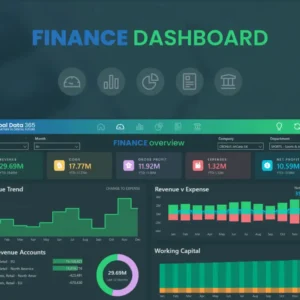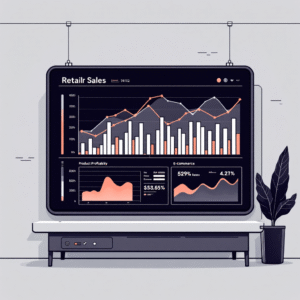Table of Contents
ToggleWhat is Power BI (and why teams adopt it)?
Power BI is Microsoft’s modern business intelligence platform that connects to your data, transforms it, and delivers interactive dashboards and AI-assisted insights across web and mobile. At its core, you model data once, then answer many questions—fast.
Unlike legacy BI or spreadsheet-only reporting, Power BI is built for self-service analytics. Business users can explore governed data, slice by any dimension, and publish insights in minutes, while IT keeps data clean, secure, and compliant.
Power BI also fits into the Microsoft 365 stack (Excel, Teams, SharePoint, OneDrive, Fabric, Azure), so it slides into existing workflows. That means fewer context switches, better adoption, and more ROI.
Talk to an expert: Have questions or want a tailored demo for your data?
Email: info@powerbigate.com Call/WhatsApp: +1 281 631 3767 Schedule: Book a 30-min Google Meet via Calendly
20+ reasons organizations use Power BI
1) True self-service analytics
Enable non-technical stakeholders to answer day-to-day questions without waiting on data teams.
2) Single source of truth
Model once, agree on the definition of every KPI, and eliminate spreadsheet sprawl.
3) Interactive, drill-down dashboards
Drill from a KPI to region → product → customer in a few clicks.
4) Tight Microsoft ecosystem integration
Share dashboards in Teams, embed in SharePoint, analyze in Excel, secure via Entra ID.
5) Cost-effective licensing & TCO
Flexible per-user and capacity options make enterprise BI attainable for SMBs and scale-ups.
6) Scales from startup to enterprise
Handle millions (even billions) of rows via import, DirectQuery, or composite models.
7) Strong data modeling (DAX & star schema)
Measure once, reuse everywhere; build sophisticated time intelligence in minutes.
8) Automated refresh & scheduled delivery
No more manual exports. Dashboards update on schedule; alerts notify exceptions.
9) Robust governance & security
Row-level security (RLS), object-level security (OLS), lineage, sensitivity labels, and audit logs.
10) Cloud, on-prem, and hybrid connectivity
Connect to SQL Server, ERP/CRM, data lakes, CSVs, APIs—almost anything.
11) AI-assisted insights
Anomaly detection, Q&A natural-language query, Smart Narratives, and more.
12) Collaboration & sharing
Workspaces, app deployment, version control, and controlled audience sharing.
13) Mobile-ready
Native iOS/Android apps for execs and field teams on the go.
14) Embedded analytics
Embed Power BI in portals, products, and internal tools to meet users where they work.
15) Standards & templates
Publish dataflows, datasets, and report templates that scale with your org.
16) Performance tuning tools
Performance analyzer, aggregations, incremental refresh, dual storage mode.
17) Flexible visuals
Built-in gallery + certified custom visuals; tailor the story to your audience.
18) Data culture accelerator
When answers are one click away, teams ask better questions and act faster.
19) Faster month-end close
Finance teams automate reconciliation and KPI packs to close earlier with confidence.
20) Auditability & compliance
Lineage and data sensitivity help satisfy regulatory and internal controls.
21) Partner ecosystem & community
A massive ecosystem of experts, content, and solutions to accelerate outcomes.
Chart: Why teams adopt Power BI (illustrative)
Use this visual in your post or social snippets. Right-click to save, or download directly: powerbi_reasons_bar.png.
Common, high-value use cases by team & industry
Finance & FP&A
-
Automated P&L, balance sheet, cash flow, budget vs actuals
-
Driver-based forecasting and scenario planning
-
Working capital dashboards (DSO/DPO/DIO)
SaaS & Subscription
-
MRR/ARR, churn, expansion, cohort analysis
-
Product usage, feature adoption, funnel analytics
Sales & Marketing
-
Pipeline health, win rates, territory performance
-
Campaign ROMI, channel attribution, lead velocity
Operations & Supply Chain
-
Inventory turns, OTIF, capacity utilization, route optimization
-
Supplier performance and cost-to-serve
HR & People Analytics
-
Headcount, attrition, hiring pipeline, DEI metrics
-
Engagement and performance dashboards
Manufacturing
-
OEE, scrap rates, downtime analysis, predictive maintenance
Healthcare
-
Patient flow, LOS, readmissions, claims analytics (with PHI safeguards)
Education & Public Sector
-
Enrollment trends, outcomes, grant reporting, transparency portals
Power BI vs. Excel: when to use which
| Scenario / Feature | Excel | Power BI | Best For |
|---|---|---|---|
| Ad-hoc analysis & modeling | Excellent | Good | One-off exploration, small datasets |
| Repeatable, governed dashboards | Limited | Excellent | Department/enterprise reporting |
| Data volume (millions+ rows) | Struggles | Handles via import/DirectQuery | Large datasets & near real-time |
| Collaboration & distribution | Email/SharePoint | Apps, workspaces, Teams | Wide audience, role-based access |
| Security (RLS/OLS, sensitivity) | Basic | Advanced | Compliance & least-privilege |
| Automation & refresh | Macros/Power Query | Scheduled refresh/dataflows | Hands-off reporting |
| Embedding in apps | Limited | Built-in | Internal portals & products |
Deep dive: See Power BI vs Excel for Financial Reporting and Power BI vs Excel (linked below) for detailed comparisons and decision criteria.
Data sources: where Power BI pulls data from
Power BI connects to:
-
Databases: SQL Server, Azure SQL, PostgreSQL, MySQL, Snowflake, BigQuery, Oracle
-
Files & Cloud Storage: Excel/CSV, SharePoint/OneDrive, Azure Blob/Lake
-
Business Apps: Dynamics 365, Salesforce, HubSpot, Google Analytics, ServiceNow, SAP, QuickBooks, Xero
-
APIs & Web: REST endpoints, custom connectors
-
Real-time: Streaming datasets, push APIs, Event Hubs, Fabric Real-Time Intelligence
This breadth is a key reason Power BI becomes the “hub” for analytics—your teams don’t need to switch tools every time a new system appears.
ROI: time saved, costs reduced, value created
A practical way to estimate ROI is to track hours saved, decisions improved, and tool consolidation.
Sample formula:
ROI (%) = (Annual benefits − Annual costs) ÷ Annual costs × 100
Where:
-
Annual benefits = (hours saved × fully loaded hourly rate) + avoided license cost + value of improved decisions
-
Annual costs = license + training + expert setup + maintenance
Chart: Reporting time saved after rollout (illustrative)
Drop this image into your article as a proof-of-value visual. Download: powerbi_time_savings_line.png.
Example:
-
Team of 8 analysts saves 20 hours/month each after 3 months → 8 × 20 × 12 = 1,920 hours/year
-
At $60/hour fully loaded → $115,200 annual labor capacity unlocked
-
Licensing + setup + training totals $25,000 in year one
-
ROI ≈ (115,200 − 25,000) ÷ 25,000 × 100 = 360.8%
Even if your inputs are half as strong, the ROI is compelling.
Governance, security & performance best practices
-
Adopt a hub-and-spoke model: Central, certified datasets + team-level reports
-
Define KPIs & grain upfront: Agree on business logic before visuals
-
Use star schemas: Fact tables + conformed dimensions = performance & clarity
-
Apply RLS/OLS and sensitivity labels: Principle of least privilege by default
-
Incremental refresh & aggregations: Keep models fast and fresh
-
Dataflows & shared datasets: Reuse transformations; avoid duplicate logic
-
Naming standards & documentation: Easier onboarding and maintenance
-
Monitor with admin & activity logs: Track usage, refresh health, and adoption
Implementation roadmap (quick start)
-
Assess & align — Identify 3–5 KPIs that matter most to leadership and frontline teams.
-
Connect data — Prioritize systems with the highest impact (ERP/CRM/Finance).
-
Model & validate — Build a star schema; write DAX for the chosen KPIs; validate with SMEs.
-
Design dashboards — Start with a one-page executive view; add drill-throughs for detail.
-
Govern — Configure workspaces, RLS, sensitivity, refresh, and change management.
-
Pilot & iterate — Roll out to a small audience, collect feedback, refine.
-
Scale — Publish an app, train users, certify datasets, and expand use cases.
Tip: Win early by automating one painful monthly report. Use the time saved to build your next dashboard.
FAQs
Is Power BI only for big enterprises?
No—SMBs get the same analytics engine with flexible per-user pricing.
Can I keep some data on-prem?
Yes—use gateways for secure on-prem connectivity and hybrid scenarios.
What if our data quality is poor?
Start anyway—identify critical fields, fix at the source, and apply Power Query rules.
Do I need a data warehouse first?
Not always. You can begin with essential sources, then formalize into a warehouse or lakehouse as you scale.
Key takeaways
-
Power BI centralizes definitions, accelerates time-to-insight, and scales securely.
-
It’s ideal for self-service dashboards that standardize KPIs across teams.
-
Strong ROI comes from automation, governed reuse, and fewer ad-hoc requests.
-
Start small: pick a high-impact report, deliver it well, and expand from there.
Summary
Power BI is used because it blends governed data modeling, interactive visualization, Microsoft ecosystem fit, and enterprise-grade security with a sensible cost structure. It helps leadership steer with real-time KPIs, empowers business users to answer their own questions, and gives data teams the tooling to scale analytics responsibly. Adopt best practices early, and Power BI becomes the backbone of a durable data culture.
Need help building or tuning your Power BI dashboards?
Email: info@powerbigate.com Call/WhatsApp: +1 281 631 3767 Schedule: Book a 30-min Google Meet via Calendly
Related reading on PowerBIgate
Notes for your editor (optional)
-
Use the two provided PNGs inside the post for visual engagement:
-
Add an FAQ schema block and internal link blocks to strengthen SEO.
-
Keep “Why Power BI is used” as the H1 to align with the exact-match query intent.







